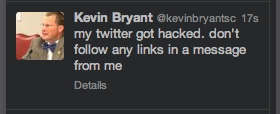Last week, Anderson’s Independent Mail published a column I wrote concerning Senator Bryant’s response to the SC DOR hacking. Specifically I was bothered with his public response to this avoidable situation. And then Monday evening (1/15/13), he publicly announces his Twitter account had been hacked.
So let’s rewind to 2012. During a breakfast last December, Senator Bryant shared his thoughts about the hacking. Here are his thoughts reported by the IndependentMail.com:
“The security lapses that made the hacking possible are ‘just mind-boggling,’ said Bryant, adding that he and other state lawmakers had no inkling that the Department of Revenue was so vulnerable.”
Well…I wonder if he is starting to realize that hacking, specifically cyber security should be an everyday concern. He seemed a bit concerned with his announcement via Twitter Monday evening. This is the actual text from above:
via @kevinbryantsc – “my twitter got hacked. don’t follow any links in a message from me”
I then noticed I had received a private message from Senator Bryant:
The private Twitter message reads from Senator Bryant: “Did you see this pic of you? lol http://bit.ly/LINK-FROM-ABOVE”
The only way I can receive a private message via Twitter from Senator Bryant’s account…if he is following me and I am following him.
Yep…do you think this is a concern. Well, it should be given his professional and political status in South Carolina. For most of us in the digital space, we remember some famous hackings:
1) NBC News Twitter account hacked with false reports about an airplane attack at Ground Zero, the Manhattan site of the original 9/11 attacks.
2) Westboro Baptist Church Members Twitter accounts were hacked by @cosmothegod posting out a petition calling for the White House to recognize Westboro Baptist Church as a hate group.
3) How about Axel Rose, his hacked Twitter account shared, “All upcoming Guns N’ Roses dates are officially canceled. Please contact your place of purchase for any refunds.”
4) Finally, who could not forget the BP Oil Spill. Leroy Stick created the fake BP Twitter account and began tweeting responses to the Gulf Coast oil spill. Here is one:
Via @BPGlobalPR – “Not only are we dropping a top hat on the oil spill, we’re going to throw in a cane and monocle as well. Keeping it classy.”
Senator Bryant should not feel alone, there have been an increase in Twitter hackings this new year. I have been advising my clients to make password changes across all digital platforms, from email to social media accounts.
I guess there is a reason why groups like McNair Law Firm sponsor events like InnoVision that focus on the liability of computer hacking.
From events this spring in Columbia like POSSCON 2013 to groups like IT-oLogy, cyber security is a huge discussion in the State of South Carolina. I am hoping these events will eventually encourage government agencies and representatives join the conversation, because the South Carolina’s private sector is screaming it from the roof tops.










